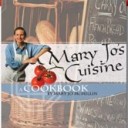 It’s always fun to read a cookbook written by a friend. As the words lift off the page, I hear a familiar voice, see a face, remember a style—and I know what the result will be.
It’s always fun to read a cookbook written by a friend. As the words lift off the page, I hear a familiar voice, see a face, remember a style—and I know what the result will be.
When Rory O’Connell’s excellent book, Master It, arrived from the UK a few days ago, I thought I heard him lecturing to a group of Cookery School students as I read his comments about how to test a roast chicken for doneness and sample the unique flavor of an Thai Nam Jim.
Then I saw the recipe for A Plain Cake In A Tin. I doubted this cake recipe from the start. The list of ingredients seemed out of balance (that much liquid?), the method seemed strange (dumping all the butter and flour straight on the whipped eggs?), but given Rory’s perfectionism I had to give it a try.
I’d been searching for the perfect PLAIN cake for ages. I wanted a cake not too sweet, not too rich and one with a velvety texture. A cake simple enough in flavor to have with a cup of tea in the morning or a hot cocoa at night. No icing, no filling, no chocolate chips or cinnamon, just CAKE. And true to form from Ballymaloe, I found it. Here’s the recipe ever so slightly Americanized.
A Plain Cake
1 stick unsalted butter (4 oz. or ½ cup)
3 large eggs
200 grams sugar (7 oz. or 1 cup)
grated rind 1 medium lemon
300 grams all purpose flour (10½ oz. or 2 scooped cups + 2 T.)
3 teaspoons baking powder
¼ teaspoon fine salt
100 ml cream (3½ oz. or ½ cup-1T.)
150 ml whole milk ( 5½ oz. or 2/3 cup)
1 teaspoon vanilla
Before you begin: for the most accurate measurements use a gram scale and the milliliter side of a liquid measuring cup. Alternatively, use the ounces or cups specified. I like to make this cake in three small 6-by-3½-inch loaf tins (one for me, one to give away and one to freeze); or use a large 9-by-5½-inch tin with extended baking time. Butter and flour the tins or line them with baking parchment.
Eggs whip faster and higher if they are not cold. Before using eggs removed from the refrigerator, allow them to warm in the shell in a bowl of warm water for 15 minutes. Measure milk and cream, add vanilla and let stand at room temperature. Melt butter in small saucepan and cool to tepid. Sift flour with salt and baking powder. Preheat oven to 375º.
Break eggs into the bowl of a stand mixer with the whip attached. Beat the eggs until foamy and gradually pour in the sugar. Whip on high speed for about 10 minutes, until light in color and the consistency of soft whipped cream.
Remove bowl from mixer, sprinkle over grated lemon rind, pour melted butter around the edge of the egg foam and gently shake sifted flour mixture over the top. Use a rubber spatula to fold all together gently and thoroughly. Add the milk mixture in four or five additions incorporating each with the folding motion. In a few minutes the mixture will come together into a smooth cake batter.
Divide the batter evenly between the tins. Rap them once or twice on the counter top to settle. Place in the preheated oven. Bake the small cakes 30-35 minutes or a larger cake 40-45 minutes or until well risen, golden, firm and tests done. (To test for doneness insert a cake-testing skewer or a toothpick into the center. If it emerges clean the cake is done; otherwise, return it to the oven for 5 minutes.) Allow the cake to rest in the tins for 5 minutes before turning out onto a cooling rack. Enjoy while fresh (even warm) and when cool, store in an airtight tin or plastic box for a week.
